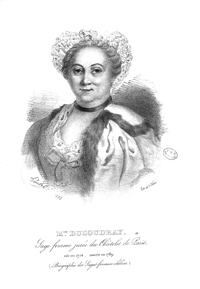Paid labor
Midwives

Midwifery's move was relatively recent to medical standards of practice. [9] In the 16th century, university training became a norm for male physicians and increasing worry started to permeate throughout Europe concerning midwives and their training. [10] Men did not rival midwives in childbirth care until midwives' training was questioned. [11] It would take four centuries for men to be the majority in childbirth. [11]
Supporters of licensing midwives said was that midwives learned the trade of childbirth through trial and error. [12] As well, midwives were consistently accused of practicing witchcraft. [13] Throughout Europe, midwifery and witchcraft had strong ties. Reasons for those ties included midwives' use of empiricism. [14] This, along with their use of herbs and mixtures, including the highly toxic belladonna, made them a target of the church and claims of witchcraft. [15] Women knew that ergot helped in labor and that certain herbs such as pennyroyal or savin "forced the courses", or in simpler terms, caused abortions. [16] Distrust grew of midwives, especially among middle and upper classes. [17]
Despite increasing backlash, midwives continued to play an important role within communities. [18] Countries such as Spain, Italy, and Holland opened schools for midwives. But these were unaccessible for many women, so apprenticeships continued to play an important role. [18] In France, King Louis XV, concerned about the infant mortality rate combined with the deaths of soldiers in the Seven Years' War, commissioned Angélique du Coudray to travel throughout the country and train both men and women in proper labor and childbirth care in the 18th century. [2] Another important French midwife was Marie Anne Victoire Gillain Boivin, who advocated for formal midwifery training, and in addition, "invented a new pelvimeter and a vaginal speculum and was the first to listen to a fetal heart using a stethoscope." [19] In England, efforts to train midwives differed. There was not much literature written on the subject and the works that were accessible in English were often translated and carried a negative connotation. [20] It was not until 1671 that a woman midwife, Jane Sharp, authored a book about midwifery, entitled The Midwives Book. [21] In it, she encouraged women to continue to being midwives, as they were in other cultures, which was in response to more man-midwives entering the field. [22]



Increased pressure put on midwives and their defense, also put midwives in a negative light. One work described them as "shy and sulky", arrogant, superstitious, and that they rushed mothers in delivery. [23]
Healers
Throughout European history, women were taught knowledge of healing, most often from childhood. [6] When medicine as a profession in 13th century Europe, women healers started to be pushed from view.[ clarification needed ] [24] Licenses began to be required to practice medicine, but even so, this was only enforced for some clienteles. [25] Literate women who often shared clients with trained physicians were the most targeted group for these checks. [25]
While literate women were often targeted for lacking a license, poor women who were the most vulnerable to accusations of witchcraft, [15] due in part, to the trust that women, also named "witch-healers", had in their ability to heal. [26] The church disliked that women healers relied heavily on their intuition and that they trusted that new cures could be discovered. [24]
Those cures consisted of different herbal preparations. [15] They looked at herbs and plants for their medical potential and also for the symbolic factor. Different plants carried different meanings. For example, violets symbolized humility and columbine stood for perseverance and steadfastness. [27] There were also women who were alchemists. One such woman, as recorded by Lady Anne Clifford, was her mother who "was a lover of the study of medicine and the practice of Alchimy. She prepared excellent medicines that did much good to many." Anne would go on to use these same preparations in her own family. [28] She was not the only woman who practiced alchemy. Many women would prepare and study medicine and prepare it on a larger scale. [16]